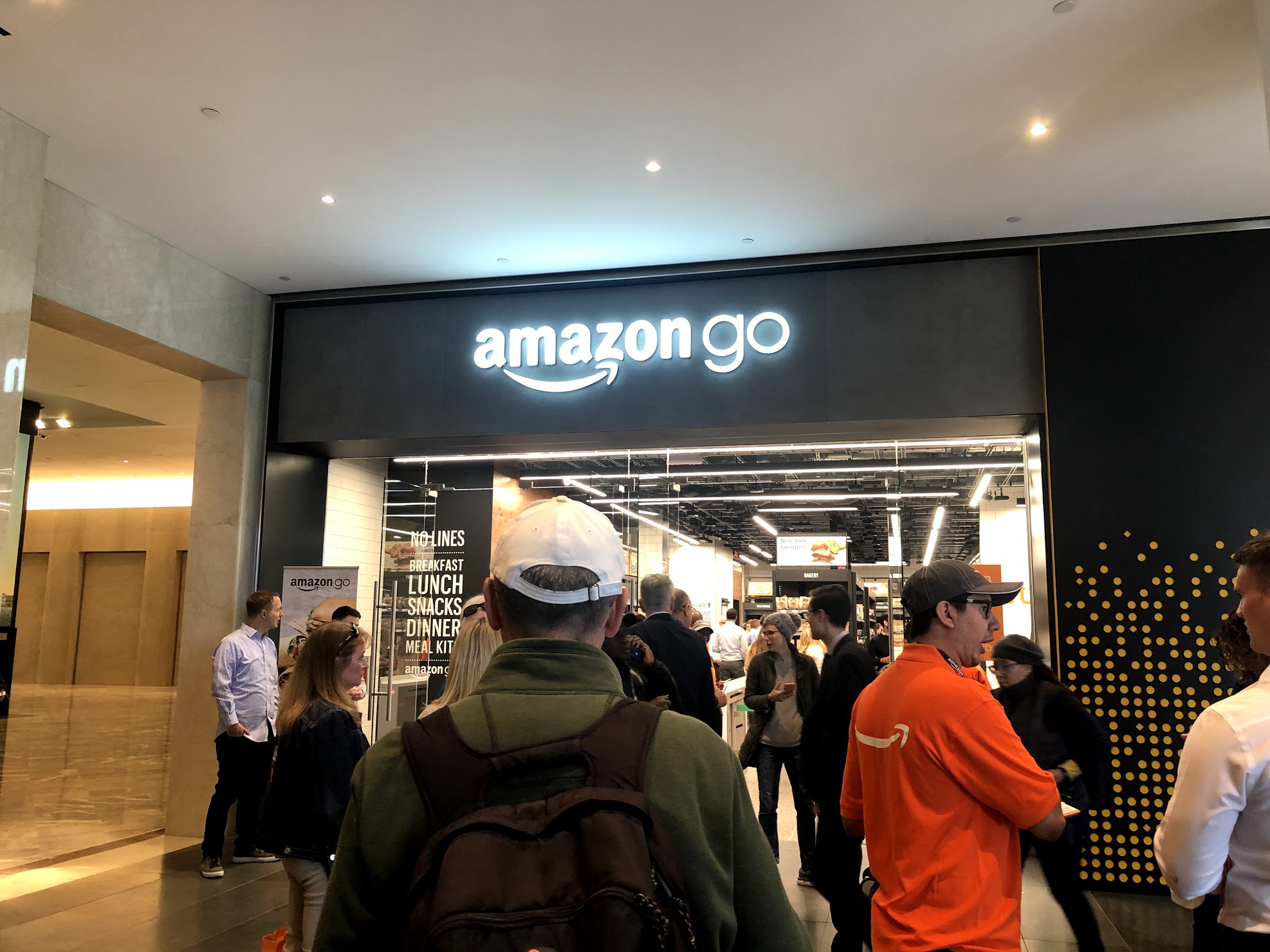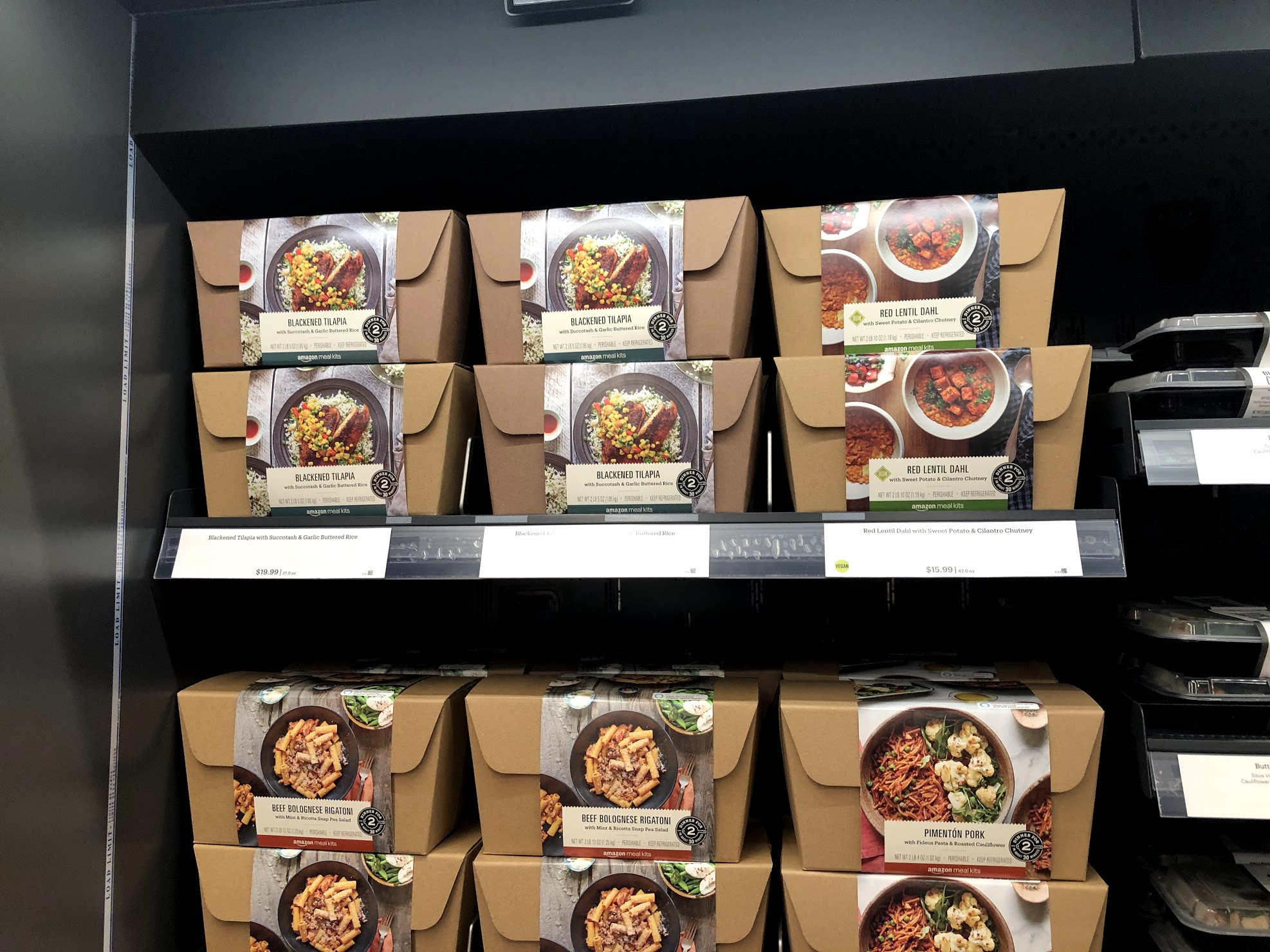My Trip to Amazon Go: The Surveillance State Sure Is Convenient!
Amazon opened its first cashier-less convenience store in New York City. It was the oddest shopping experience of my life.
Imagine a grocery store with no cash registers. No tedious checkout lines, no mixing up your items on the conveyor belt, no fiddling around for your credit card or counting out your change.
It sounds almost too good to be true. So I paid a visit to Amazon Go, Amazon's cashier-less convenience store, on its opening day in New York City. The only sacrifice you make: near-constant surveillance.

Amazon Go's signature feature is its lack of cashiers. Every item you take off a shelf is automatically added to your online Amazon shopping cart, and your account is charged when you exit the store. The company uses a combination of computer vision and AI to detect who's putting which items in their cart.
Unlike the 11 other Amazon Go franchises in Chicago, San Francisco and Seattle, New York's location offers customers the option to pay in cash and has cashiers. An employee told me that cashiers will be rolling out to other locations in the future.
The Elite Turnstiles
New York's Amazon Go is open 6 a.m.-8 p.m. Monday through Friday, and 7 a.m. - 8 p.m. on weekends. I arrived around 11 a.m., a few hours after the store's inaugural opening.
A large crowd of bewildered-looking people was gathered outside. Amazon employees, denoted by bright orange shirts, wove through the crowd handing out explanatory flyers. "No Lines. No Checkout," the handouts proclaimed.
Pretending to have no idea what this "Amazon" thing was, I asked a grinning employee for information. He very enthusiastically walked me through the steps to download the Amazon Go app to my phone and sign into my Amazon account. Doing so brought up a QR code, which I needed to scan to get into the store.
Get instant access to breaking news, the hottest reviews, great deals and helpful tips.
After the employee bid me a cheery goodbye, I entered the store with a spring in my step. Despite knowing that anyone with a (free) Amazon account can enter a Go store, I still couldn't help feeling like a member of a privileged elite when the turnstile opened for me.
You Are Being Watched
Amazon Go feels similar to most upscale convenience stores, with one key difference: You are being watched.
The aisles were lined with orange-shirted employees. They were amicable, making conversation and urging me to try various products ("You must eat this before you die," one stocker remarked of a Magnolia Bakery cookie). Still, as I combed through the aisles, I was creeped out. I was afraid to pick up and examine too many items; I didn't want to look like I was up to anything shady.

I know that in practice, this isn't dissimilar to a real convenience store, where security cameras have their eye on you. But it feels very different to have physical people standing along the aisles. And I was there while the store was packed with shoppers; I imagine the effect would have been amplified were I one of only a few folks in the store. Amazon wouldn't say if the number of orange shirts walking around the store was typical, or more than usual owing to its grand opening in New York.
This Is A Convenience Store
Several of my fellow customers were confused about this, so allow me to clarify: Amazon Go is a convenience store. Despite the fact that news sources often refer to Go as a grocery store, and that some western locations claim to offer "grocery essentials", the New York location sells neither produce nor fresh meat. You will find most of the same foods you'll find at a gas station: hot dog buns, chips, Vitamin Waters, protein cookies, the works.
The main attraction, however, is a large stash of Amazon-branded meal kits and to-go dishes in various shapes and sizes. These were the shelves that received the most attention. "I'm definitely getting lunch here," a customer next to me in the sushi section said. "Probably dinner too." There was a wide selection of meals, from beef bolognese rigatoni to chicken and sausage jambalaya.

Unfortunately, as someone who keeps a very low-calorie diet, I had trouble finding a healthy snack. Even the small convenience store on my street carries small containers of fruit and nuts. The closest Amazon Go came was a large box of apple slices and several massive chunks of pineapple, neither of which were practical as a grab-and-go snack. There were small amounts of carrots and celery, but those tended to come with hummus, yogurts, and other fatty dips.

I was disappointed not to see more of a focus on nutrition and locally sourced products from the company that owns Whole Foods and Amazon Fresh. I know many folks will see this as a nitpick, and it is—but it makes it much harder for me to shop there.
The Great Checkout Adventure
After surveying my snack options, I picked up an oatmeal cookie and some Advil.
I paid for the oatmeal cookie the traditional (if it can be called that) way: I stuck it in my backpack and walked out of the store. That went off without a hitch. When I was just a few steps away from the turnstiles, I received a notification from the Amazon Go app informing me of how much I'd paid for the snack, and that I'd spent 15 minutes in the store overall. I felt like I'd arrived in The Future.
When I tried to pay for the Advil with cash, I wasn't so lucky. It wasn't clear who or where the alleged cashiers were, so I flagged down a nearby employee and asked for help. I was sent on a bit of a wild goose chase from there: I was directed to an employee in another aisle, who sent me to an employee in yet another aisle, who told me to wait for another employee who would come assist me. "Hey, we've got a cash payer over here!" he called to his associate.

After being ping-ponged around the store for around five minutes, I finally touched base with a cashier. Unfortunately, he wasn't quite sure how to ring me up, so we had to wait another minute or so for another cashier to come assist.
It turned out that for me to pay in cash, the Amazon employees had to remove the Advil from my online shopping cart. This meant I had to hand over my phone so they could access my account information. I wasn't super comfortable with this, but felt I'd sunk too much time into the operation to back out.
Corporate Reusable Bags
Cookie and Advil in hand, I made to leave the store, but one more surprise awaited me. On the way out, an employee handed me a bright orange tote bag with the white Amazon Go logo emblazoned down the front. Everyone who walked by was offered a bag, and they were completely free, though some customers took convincing. ("Wait, we don't need to pay for these at all? Are you sure?" asked a bewildered woman behind me).
It was convenient, and I'm very glad to see Amazon taking a step away from plastic bags. I did, however, feel like a bit of a corporate shill carrying it around the subway after. The colors aren't subtle.
Repeat Customer
If you're someone who's disgusted by the thought of corporations knowing what links you click on, you'll want to stay far away from this store. Not only will Amazon know what meals you're purchasing, but its physical incarnations will watch you as you go about your shopping.
But if you can past the surveillance, and you don't mind Amazon gaining even more information about what you buy and eat, Amazon Go is convenient. It's a true pop-in, pop-out experience, as long as you're not trying to pay with cash.
It's creepy and it's awesome. I'm totally going back.
Image Credits: Tom's Guide
Monica Chin is a writer at The Verge, covering computers. Previously, she was a staff writer for Tom's Guide, where she wrote about everything from artificial intelligence to social media and the internet of things to. She had a particular focus on smart home, reviewing multiple devices. In her downtime, you can usually find her at poetry slams, attempting to exercise, or yelling at people on Twitter.
